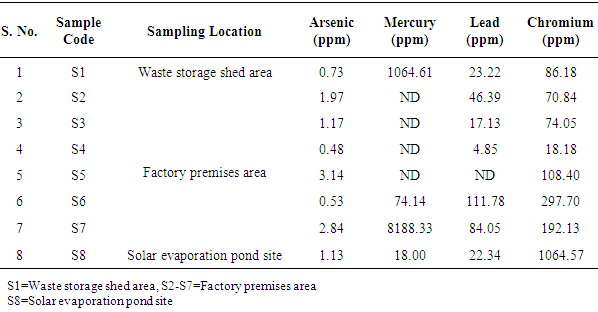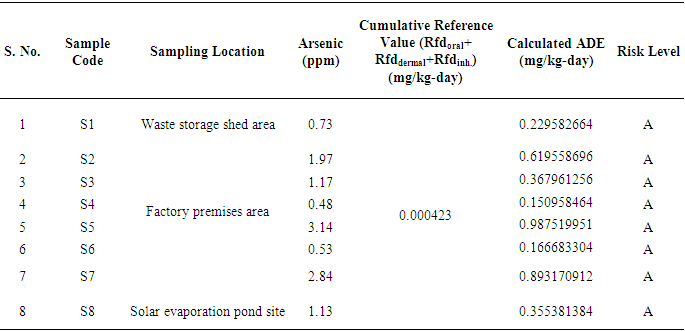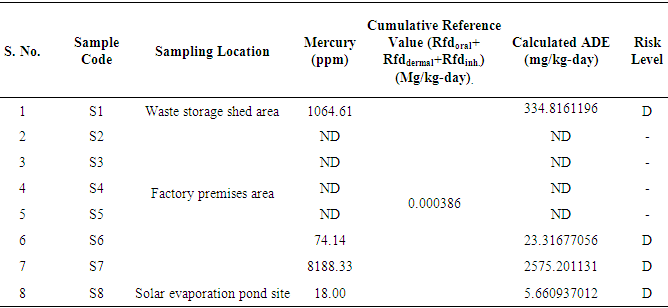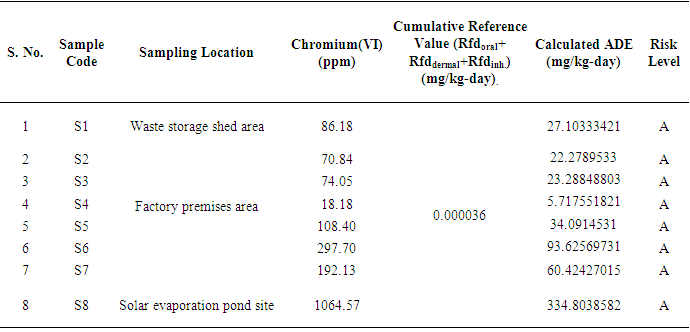-
Paper Information
- Previous Paper
- Paper Submission
-
Journal Information
- About This Journal
- Editorial Board
- Current Issue
- Archive
- Author Guidelines
- Contact Us
Resources and Environment
p-ISSN: 2163-2618 e-ISSN: 2163-2634
2016; 6(6): 148-153
doi:10.5923/j.re.20160606.08

Assessment of Health Risk due to Contaminated Soil and Remediation Techniques – A Case Study
Abhishek Dixit, Surendra Roy
Department of Civil Engineering, PSIT College of Engineering, Kanpur, India
Correspondence to: Abhishek Dixit, Department of Civil Engineering, PSIT College of Engineering, Kanpur, India.
| Email: |  |
Copyright © 2016 Scientific & Academic Publishing. All Rights Reserved.
This work is licensed under the Creative Commons Attribution International License (CC BY).
http://creativecommons.org/licenses/by/4.0/

The rapid growth of industrialization, urbanization and use of pesticides in agricultural field has been causing land contamination. The industrial disaster took place on December 2, 1984 at Union Carbide India Limited pesticide plant in Bhopal. Many casualties occurred during this tragedy. Due to leakage of methyl isocyanate (MIC), not only the land in and around the factory premises but also groundwater got contaminated. The effects of heavy metals (arsenic, chromium, lead and mercury) present in the soils of plant area on the human being were studied. For this, the exposure pathways (direct and indirect soil ingestion; inhalation and dermal contacts) through which human being could be effected was considered. The age group (16-59 years), body weights, respiration rate, etc were also taken into account. The carcinogenicity classification values for each heavy metal were obtained from USEPA's Integrated Risk and Information System (IRIS). Dose intakes of contaminated soil were calculated using CLEA model. The concentrations of heavy metals of gas plant area were taken from the CSE Report, 2009. The cumulative average daily exposure (ADE) indicated that arsenic and chromium have higher risks to the receptors as these can cause carcinogenic problems. Lead and mercury have also higher exposure value compared to reference value, which can cause diseases like failure of nervous system, liver, kidney etc. The remediation techniques of the heavy metals from the contaminated soils have also been focused in this paper.
Keywords: Contaminated Soils, Heavy Metals, Risk Assessment, Average Daily Exposure, Remediation
Cite this paper: Abhishek Dixit, Surendra Roy, Assessment of Health Risk due to Contaminated Soil and Remediation Techniques – A Case Study, Resources and Environment, Vol. 6 No. 6, 2016, pp. 148-153. doi: 10.5923/j.re.20160606.08.
Article Outline
1. Introduction
- Contaminated land is that land, which has elevated concentrations of chemicals or other substances (contaminants), resulting due to human activities. Now a day, the contamination of land is the major issue but the manufacturers of pharmaceuticals, paints, pesticides, chemicals, steel and metallic products and other industries have been ignoring these issues from the past several decades. There are number of industries, which produce different type of wastes, are also responsible for the land contamination. The heavy metal is a metallic chemical element that has a relatively high density and is toxic or poisonous at low concentrations. The heavy metals that are harmful to humans include mercury, lead, and arsenic. It releases from the industries and travels through for large distances and is deposited onto the soil, vegetation and water depending on their density. Once deposited, these metals are not degraded and persist in the environment for many years poisoning humans through inhalation, ingestion and skin absorption [1]. Once the heavy metals enter the ecosystems, the biological community including the human population can be affected. The metal concentration influences with age, sex and body mass index as well as life-style habits (smoking, alcohol consumption and food habits) [2]. Humans are exposed to heavy metals through inhalation of air pollutants, consumption of contaminated drinking water, exposure to contaminated soils or industrial waste, or consumption of contaminated food. Food sources such as vegetables, grains, fruits, fish and shellfish can become contaminated by accumulating metals from surrounding soil and water. The land contaminants may cause a variety of health problems starting with minor problems like skin rash, eye irritation, headache to major health issues like cancers, nervous system damage, neuromuscular blockages, kidney and liver damage, problems in the respiratory system, long term illness and the ultimate risk of death and genetic effects. The land contaminant is not only harmful for the people who work on the disposal sites but also for the people who have been living nearby the areas.On December 3, 1984, toxic poisonous methyl isocyanate gas leaked from Union Carbide India Limited (UCIL's) pesticide plant in Bhopal. The gas leak triggered a disaster that is now widely recognized as the world worst industrial catastrophe. Thousands of people were killed instantly and more than 25,000 people died from gas-related illnesses [3]. Greenpeace and other organizations, including the Centre of Science and Environment (CSE), found high concentrations of chloro benzenes and volatile and semi-volatile organochlorines, as well as metals such as chromium, copper, nickel, lead, zinc and mercury in the local water and soil. Mercury concentrations, seven million times higher than the World Health Organization's recommended limits, have been recorded and all the water pumps in the area have been found to be heavily contaminated with toxins and metals. A recent article by a web news service in India claims that around 700 tons of toxic waste in the form of corroded metal and other scrap generated by Union Carbide now lie scattered and exposed in the factory premises and have worsened the sufferings of victims living nearby [4].Health risk assessment is defined as the characterization of the potential adverse health effects of human exposures to environmental hazards [5]. Risk-based assessment is a way to evaluate the potential hazards of contaminated sites and is based on considering linkages between pollution sources, pathways, and receptors. These linkages can be broken by source reduction, pathway management, and modifying exposure of the receptors [6].Remediation of contaminated soil is an action, including removal, chemical, physical, or biological treatment of soil, groundwater, or other environmental media, intended to restore or improve the land condition impacted by chemical contamination. The improvement of a contaminated site is to prevent, minimizes, or mitigate damage to human health or the environment. Remediation involves the development and application of a planned approach that removes, destroys, contains or otherwise reduces availability of contaminants to receptors of concern [7, 8]. Though environmental pollutants generated due to gas tragedy around two decades back, but its hazardous effects on the groundwater and soil are still lying in the premises of gas plant area. Many researchers have analyzed the groundwater and soils samples and found the concentrations of different contaminants but they have not assessed its direct and indirect impacts on human health. In this study, attempts have been made to determine the level of risk generated due to contaminated soils on human health and suggestive remedial measures for its minimization.
2. Methodology
2.1. Data Collection
- The city of Bhopal, Madhya Pradesh, India suffered the world’s worst industrial disaster in December 1984, where around 5, 00,000 inhabitants were exposed to toxic gas (Methyl Isocyanate) from the Union Carbide India Ltd (UCIL) pesticides factory. Thousands of people died immediately. UCIL used to manufacture three different kinds of pesticides such as Carbaryl (trade name Sevin), Aldicarb (trade name Temik), and a formulation of Carbaryl and gamma-hexachlorocyclohexane (γ-HCH), which were sold under the trade name Sevidol. Carbaryl and Aldicarb fall under carbamate group of insecticides; both are moderately persistent, highly toxic; highly water soluble and mobile in soils. The soil contaminants data were taken from the report. The concentration of heavy metals like lead, chromium, mercury and arsenic available in soil were used to assess the hazardous impacts on human health. These concentrations have been assessed by collecting eight samples from three different locations (waste storage shed area, factory premises area of the site and solar evaporation pond site) mentioned in the CSE report [2].
2.2. Development of Program for the Risk Assessment
- To determine the health risk due to heavy metals of different models and reports i.e. UK contaminated land regime, published guidelines and technical reports [9] and other Government agencies contaminated soil, computer based program was developed using MATLAB software. The algorithm and formulation were taken from. Most of the attributes [source (chemical and toxicity parameters of heavy metals, volatile and non-volatile nature), pathways (inhalation, ingestion and dermal) and receptor (chemical exposure rate, body weight, respiration rate, skin contact area, etc.)] for the calculation of Daily Exposure Rate (ADE) were taken from different existing models like CLEA and RISC model [10, 11].At first, it was required to understand the contaminants at the site, the way through which the receptors got affected and the different attributes of the receptors. Different input parameters such as name of the contaminant with its concentrations in soil, age group of the receptor, pathways (inhalation, direct soil ingestion, indirect soil ingestion, consumption of garden vegetables, dermal contact) through which receptors got affected, type of soil, etc were taken. The heavy metals like mercury, arsenic, lead and chromium (VI) with their chemical and toxicity parameters [7, 12, 13, 14] were used in the program development. For the receptor, the parameters like respiration rate, body weight, inhalation time, dermal contact, etc. were taken in the program by default depending upon the age of the individual (from the model). Depending upon the type of land like residential, allotment and commercial, the types of soils (loamy, sandy, clay etc.) were assessed. Based on the input data, the value of Average Daily Exposure (ADE) was calculated using the Equation (1) mentioned in the “Contaminated Land Exposure Assessment Model (CLEA), Technical basis and Algorithms, 2002” [10]. Exposure assessment is used to assess the total dose entering the human body through different pathways and expressed in mg/kg/day [6].Total average daily exposure consists of three basic exposure pathways such as inhalation, ingestion and dermal is:
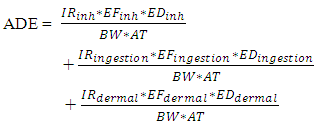 | (1) |
3. Data Analysis
- For assessment of risk in the study area, data of published report [3] was used and ADE was computed to find out the risk level.
3.1. Risk Assessment
- The details of samples, sampling locations and concentrations of different heavy metals are given in Table 1. The concentration of arsenic, mercury and lead were found higher in most of the samples of the factory premises area compared to the samples of other two locations. The concentration of chromium was the highest in solar evaporation pond.
|
|
|
|
|
3.2. Remediation Methods
- There are number of remediation technologies available for the reclamation of heavy metals contaminated soils. Based on the different criteria [9, 16], the suitable methods are suggested as under:(i) Cost effective: Soil flushing, phytoremediation and thermal desorption. These techniques are economical.(ii) Time: Electrokinetic, Soil washing and thermal desorption. These techniques are less time consuming.(iii) Risk: Electrokinetic, vitification, thermal desorption. These techniques are highly effective in the reduction of heavy metals contamination. But it may be costlier and time consuming.India is a developing country, therefore, a cost effective methods of land treatment can be chosen for the minimization of heavy metals from the contaminated site. Considering the area of the land as well as cost of the remediation techniques, phytoremediation techniques would be better option [17].
4. Conclusions
- Based on the calculated average daily exposure, the arsenic, chromium, lead and mercury showed higher levels of health hazards. The arsenic and chromium were found at all the locations. The cumulative exposure through direct and indirect soil ingestion, inhalation and dermal indicated that there is a chance of carcinogenic risk to the receptors. The lead and mercury cannot cause carcinogenic diseases but it can cause other diseases due to its higher exposure through different pathways.Electrokinetic and thermal desorption techniques can be adopted as these are less time consuming and effective to remove the heavy metals.As the effects of heavy metals through all the pathways can cause health hazards to adults (16-59 years), therefore, the children and senior citizens can also be get affected more than the adult age group. The Bhopal tragedy area is still not in use due to land contamination. It is a great economical loss to the Government and the society; therefore, the suggestive techniques can be used to remediate the contaminant land to bring it into fruitful conditions. Phytoremediation technique can be adopted as a better option.It is suggested to carry out a detail investigation of the site to find out its present contamination status for remediation.
 Abstract
Abstract Reference
Reference Full-Text PDF
Full-Text PDF Full-text HTML
Full-text HTML